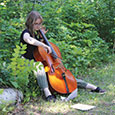If I was writing this a decade ago during my college years, I probably would not have been excited by the prospect of sharing my thoughts about the first thirty minutes of my daily practice. At that time, it would have seemed insignificant, a rather casual part of my daily work. I certainly did not realize that I would spend years developing an approach to these moments or that they would become the very essence of my daily routine.
Challenges
Once I dove into the professional world of classical music and embarked on building a versatile career, I found myself facing a great amount of solo work sandwiched between recitals, constant orchestral engagements, and regular teaching duties. It was at this point that I realized how crucial the efficiency of my practice was. I had to feel technically fit on my instrument to confidently navigate through the everyday challenges I faced. I had to be ready to jump in at the last minute and perform a core repertoire piece, rapidly learn a contemporary composition, or quickly adapt to the musical and stylistic demands of different orchestras and ensembles.
I also was surprised to realize how often I faced extreme travel conditions, including jetlag, train delays, and cancelled flights, as well as unexpected events like health issues and weather emergencies. All of these consumed a substantial amount of energy and often took a heavy toll on my practice times. These obstacles intensified exponentially when I began building a family and found myself having to manage all of these challenges while travelling with and taking care of an infant.
Getting Started
At this point, it was clear that I needed a daily practice routine that would allow me to stay on top of things. I started by determining the minimum amount of time that I could allocate every day that would also guarantee my fitness on the flute. Thirty minutes seemed just doable on almost all occasions, so I began to experiment with making the best use of this time. I identified the elements of flute playing that were the most crucial for me and also thought about what I could work on without having my instrument in hand. There was plenty I could do just through mental practice, including breathing exercises, analyzing the musical text of a given composition, practicing complex rhythmic structures, or learning music by heart. I was able to work on these on a flight, while waiting in line, walking to and from the nursery, and other free time.
The Essentials
There are four vital things that I pinpointed as necessary to my daily 30 minutes of instrumental practice. They are sound, articulation, finger technique, and intonation. I formed a sequence of exercises that would develop them. I spent years testing different warm-up methods, investigating various approaches, and trying out which sequence of exercises worked best for me. I finally ended up forming a quite simple but comprehensive program that I vary depending on what I am preparing for. It serves as a stable foundation for my everyday practice. Going through this routine with great concentration ensures that I am in good musical shape for all of the professional challenges I face.
My Practice Plan
I begin with the first exercise from Marcel Moyse’s De la Sonorité. I first go down to the very bottom and then do it again starting from the second octave B and going up to the highest possible notes. It is important to stay comfortable and relaxed and focus on the stability of the airflow while doing this. I make sure not to use any vibrato. Instead, I focus on the beauty of the core sound and consciously notice how the speed and direction of the airstream changes depending on the register and which note I am playing. All of this is done in a nice and slow tempo at a mezzoforte dynamic.
After I work on several extended scales where I make sure that I cover the full range of the flute. Here again I focus my attention on the flow of air between the notes. The goal is to achieve the smoothest legato and an equally round singing sound in every octave. I also make sure not to apply any vibrato. Because I play the scales relatively slowly, they also serve as finger exercises. Fingers should stay completely relaxed, close to the instrument, and just like the airflow, facilitate playing legato. I do each scale in thirds, fourths, and sometimes in fifths and then play Matheus André Reichart’s second exercise from 7 Daily Exercises, in the key relevant to the scale I am working on.
This is followed by adding articulation to the scales. Step one is to add legato tonguing – which should not affect the sound or the airflow in the slightest. Step two is to play each note only with a breath attack. Step three is to add tongue to these short notes while still working with the air stream. Finally, I conclude by going through the same scale with quick double tonguing.
After completing these steps, I work on vibrato, making sure that I control it well and that the vibrato itself is born out of the core of the sound. Vibrato should not influence the intonation of a given note or result in the sound becoming more airy.
Next, I address intonation. If I do not have a piano available, I use a tuner, setting it to play a given note to me. Then I go through at least one scale and several arpeggios extremely slowly, making sure that the sound is open and round, but that every single note is absolutely in tune with the note (or chord) sustained by either the piano or tuner. Then I look at a few of the most difficult technical passages of the pieces I am working on at an exceptionally slow tempo. I check their intonation in detail with the above described technique.
The two most important aspects in my warm-ups and practicing in general are focus and speed. It is of prime importance to immerse myself fully in the process and practice everything slowly.
If I can continue practicing after the initial 30 minutes, I alternate between working on repertoire pieces for upcoming performances and technical exercises. I pick a complicated section and identify musical or technical difficulties and then dissect it with different practice strategies. I prefer to practice for short periods with great attention, taking frequent breaks when I feel my concentration dropping even slightly.
I believe these practices are equally beneficial to professionals, students, and amateurs for improving general technical skills. While personal preferences and expressive styles can differ greatly, so the same routine might not work successfully for everyone. However, it is important that musicians build a clear, solid practice routine that uses their time efficiently and effectively. I encourage you to experiment with these ideas and cultivate your own rehearsal laboratory.






